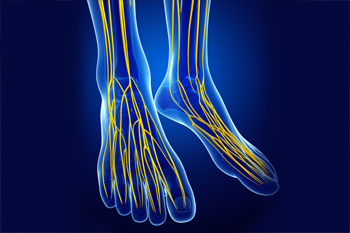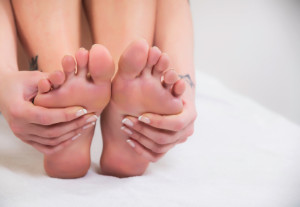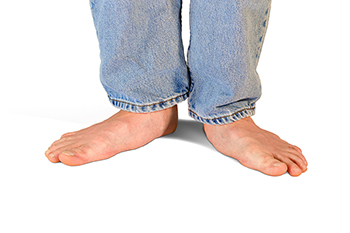Flint Office
1303 S. Linden Rd., Suite D
Flint, MI 48532

A pinched, or compressed, nerve can occur anywhere in your foot, such as in the heel, ball, or even on the bottom. A pinched nerve can produce pain or sensations of tingling, numbness, weakness, or the feeling that your foot has fallen asleep. The pain may radiate out to the toes or arches and become noticeable after exercising, walking, or standing for a while. What causes a nerve in your foot to become pinched? Injuries, medical conditions, tight ligaments, inflamed tendons, wearing tight shoes, obesity, or nerve entrapment conditions such as Morton’s neuroma. Switching footwear, resting, icing, immobilizing the area, or massaging it can sometimes provide temporary relief. However, if the symptoms persist or worsen, a podiatrist should examine your foot and run tests to determine the cause of your condition. Taking prompt, appropriate action will help reduce the risk of permanent nerve damage.
Foot Pain
Foot pain can be extremely painful and debilitating. If you have a foot pain, consult with one of our podiatrists from Community Podiatry Group. Our doctors will assess your condition and provide you with quality foot and ankle treatment.
Causes
Foot pain is a very broad condition that could be caused by one or more ailments. The most common include:
Diagnosis
To figure out the cause of foot pain, podiatrists utilize several different methods. This can range from simple visual inspections and sensation tests to X-rays and MRI scans. Prior medical history, family medical history, and any recent physical traumatic events will all be taken into consideration for a proper diagnosis.
Treatment
Treatment depends upon the cause of the foot pain. Whether it is resting, staying off the foot, or having surgery; podiatrists have a number of treatment options available for foot pain.
If you have any questions, please feel free to contact our office located in Flint, MI . We offer the newest diagnostic and treatment technologies for all your foot care needs.

The medical condition known as cracked heels can be uncomfortable. If the cracks in the skin are deep, they are referred to as fissures, and may bleed. It is an ailment that affects the heels, and it is generally caused by having excessively dry skin. This can be a result of the aging process, from wearing shoes that do not have a back, or from standing on hard surfaces for most of the day. There may be existing medical conditions that can lead to cracked heels, including eczema, psoriasis, a thyroid disorder, or a vitamin deficiency. People who are overweight may experience cracked heels, and this can be a result of the added weight the feet must endure. Some of the symptoms associated with cracked heels include flaky skin, bleeding, pain and discomfort. An effective prevention technique includes washing and drying the feet daily followed by applying a good moisturizer. Additionally, it may help to refrain from standing in one position for long periods of time and to wear shoes that have a back. If you have cracked heels, a podiatrist can prescribe effective medicine that can help to manage this condition, and it is suggested that you schedule an appointment.
Cracked heels are unsightly and can cause further damage to your shoes and feet. If you have any concerns, contact one of our podiatrists from Community Podiatry Group. Our doctors can provide the care you need to keep you pain-free and on your feet.
Cracked Heels
Cracked heels appear unappealing and can make it harder for you walk around in sandals. Aside from looking unpleasant, cracked heels can also tear stockings, socks, and wear out your shoes. There are several methods to help restore a cracked heel and prevent further damage.
How Do You Get Them?
Dry skin is the number one culprit in creating cracked heels. Many athletes, walkers, joggers, and even swimmers suffer from cracked heels. Age and skin oil production play a role to getting cracked heels as well.
Promote Healing
Over the counter medicines can help, especially for those that need instant relief or who suffer from chronic dry feet.
Wear Socks – Wearing socks with medicated creams helps lock in moisture.
Moisturizers – Applying both day and night will help alleviate dryness which causes cracking.
Pumice Stones – These exfoliate and remove dead skin, which allows for smoother moisturizer application and better absorption into the skin.
Change in Diet
Eating healthy with a well-balanced diet will give the skin a fresh and radiant look. Your body responds to the kinds of food you ingest. Omega-3 fatty acids and zinc supplements can also revitalize skin tissue.
Most importantly, seek professional help if unsure how to proceed in treating cracked heels. A podiatrist will help you with any questions or information needed.
If you have any questions, please feel free to contact our office located in Flint, MI . We offer the newest diagnostic and treatment technologies for all your foot care needs.

The feet and ankles are the foundation for stability and balance, and keeping them mobile and stable is imperative for proper functioning of the body. If we exercise our feet and ankles, we can help to prevent foot and ankle injuries and conditions. Strengthening and improving flexibility in the feet and ankles can provide a good foundation for stronger muscles and avoidance of pain. If overdone or pushed to discomfort, the opposite can happen. Exercise done wrong or pushed too far can create inflammation and torn tissues, which can restrict joint movement. Pain is an important sign to pay attention to when exercising the feet and ankles. It can let us know when we are doing something wrong or unsafe. One way of exercising the lower extremities is called Active Isolated Stretching, or AIS. This type of stretching focuses on active-assisted movements, where one moves into a stretch until the first sign of tension. With rhythmic, relaxed repetitions, there is increased blood flow and sedation of the nerves. For healthy feet and ankles, it is important to stretch the calves, ankles, and toes. As you practice exercising your feet and ankles, be gentle with yourself and ease into it. Never push so hard that you find you are holding your breath, and simply pay attention to how you feel. If you would like more information about proper exercise for your feet and ankles, consult with a podiatrist who is an expert in this area.
Stretching the feet is a great way to prevent injuries. If you have any concerns with your feet consult with one of our podiatrists from Community Podiatry Group. Our doctors will assess your condition and provide you with quality foot and ankle treatment.
Stretching the Feet
Being the backbone of the body, the feet carry your entire weight and can easily become overexerted, causing cramps and pain. As with any body part, stretching your feet can serve many benefits. From increasing flexibility to even providing some pain relief, be sure to give your feet a stretch from time to time. This is especially important for athletes or anyone performing aerobic exercises, but anyone experiencing foot pain or is on their feet constantly should also engage in this practice.
Great ways to stretch your feet:
Individuals who tend to their feet by regular stretching every day should be able to minimize foot pain and prevent new problems from arising.
If you have any questions, please feel free to contact our office located in Flint, MI . We offer the newest diagnostic and treatment technologies for all your foot care needs.

Having little or no arch in the foot can indicate flat feet. Flat feet can be observed while standing on the floor and checking to see if there is an arch present. People with this condition will see that their foot is lying flat against the floor with little or no space where the arch should be. Most babies are born with flat feet and the arch gradually develops at approximately age 10. Adults who have flat feet may have inherited them or have endured a foot injury. Additionally, there are existing medical conditions that can cause flat feet. These include arthritis, cerebral palsy, and spina bifida. People who are obese may notice they have acquired flat feet as a result of the weight the feet must bear. Some patients feel their weight is not distributed properly and the foot may roll inward. If you have flat feet, please consult with a podiatrist who may suggest wearing orthotics and can also show you how to perform specific exercises that can help with discomfort.
Flatfoot is a condition many people suffer from. If you have flat feet, contact one of our podiatrists from Community Podiatry Group. Our doctors will treat your foot and ankle needs.
What Are Flat Feet?
Flatfoot is a condition in which the arch of the foot is depressed and the sole of the foot is almost completely in contact with the ground. About 20-30% of the population generally has flat feet because their arches never formed during growth.
Conditions & Problems:
Having flat feet makes it difficult to run or walk because of the stress placed on the ankles.
Alignment – The general alignment of your legs can be disrupted, because the ankles move inward which can cause major discomfort.
Knees – If you have complications with your knees, flat feet can be a contributor to arthritis in that area.
Symptoms
Treatment
If you are experiencing pain and stress on the foot you may weaken the posterior tibial tendon, which runs around the inside of the ankle.
If you have any questions please feel free to contact our office located in Flint, MI . We offer the newest diagnostic and treatment technologies for all your foot and ankle needs.

There are thin tendons on the top of your feet that connect your toes with muscles in the front of the lower leg. These are called extensor tendons. Extensor tendons help you flex your feet and raise your toes. Because they reside just underneath the skin on the top of the feet and have no padding, they are susceptible to becoming injured, inflamed, and painful. This is known as extensor tendonitis. Extensor tendonitis can sometimes be caused by overuse, or from shoes that are too tight. Dancers, runners, skiers, and skaters are susceptible to developing extensor tendonitis because they wear shoes that lace tightly in the front which can press hard against these tendons. In this way, extensor tendonitis is sometimes a sports-related injury. Extensor tendonitis can be diagnosed and treated by a podiatrist who may need to analyze imaging tests to rule out other injuries and make sure no other damage has been done to surrounding structures. It is suggested you consult with your podiatrist for shoe modifications, stretching, and strengthening exercises, and they may prescribe anti-inflammatory drugs, suggest icing, or even prescribe steroid therapy. In very severe cases, surgery may be necessary to repair the extensor tendons.
Sports related foot and ankle injuries require proper treatment before players can go back to their regular routines. For more information, contact one of our podiatrists of Community Podiatry Group. Our doctors can provide the care you need to keep you pain-free and on your feet.
Sports Related Foot and Ankle Injuries
Foot and ankle injuries are a common occurrence when it comes to athletes of any sport. While many athletes dismiss the initial aches and pains, the truth is that ignoring potential foot and ankle injuries can lead to serious problems. As athletes continue to place pressure and strain the area further, a mild injury can turn into something as serious as a rupture and may lead to a permanent disability. There are many factors that contribute to sports related foot and ankle injuries, which include failure to warm up properly, not providing support or wearing bad footwear. Common injuries and conditions athletes face, including:
Sports related injuries are commonly treated using the RICE method. This includes rest, applying ice to the injured area, compression and elevating the ankle. More serious sprains and injuries may require surgery, which could include arthroscopic and reconstructive surgery. Rehabilitation and therapy may also be required in order to get any recovering athlete to become fully functional again. Any unusual aches and pains an athlete sustains must be evaluated by a licensed, reputable medical professional.
If you have any questions please feel free to contact our office located in Flint, MI . We offer the newest diagnostic and treatment technologies for all your foot and ankle needs.